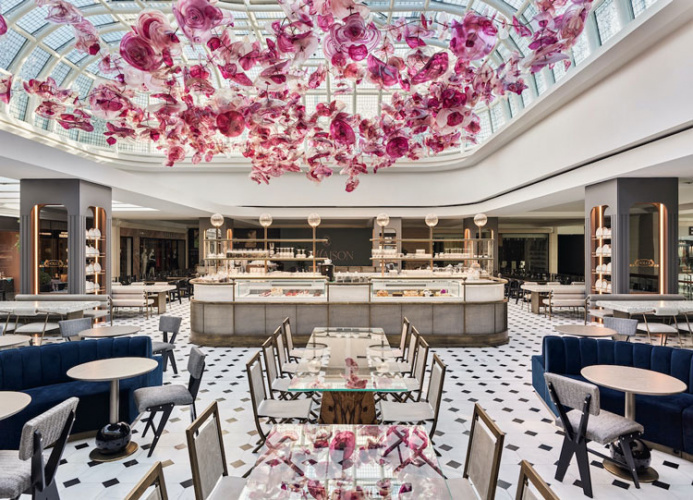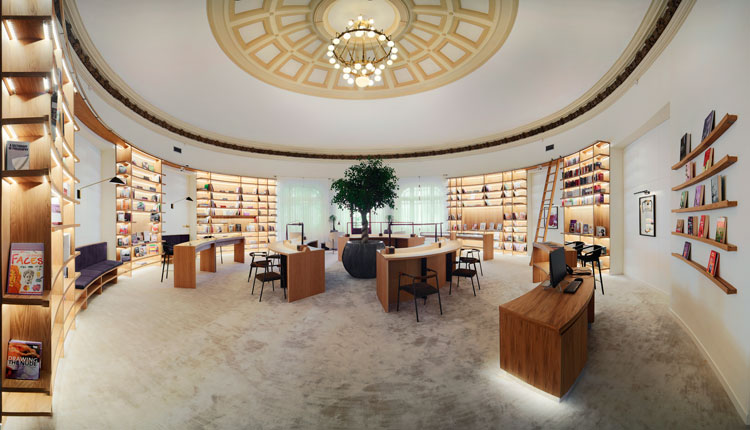Interiors inspiration: Design Week’s favourite recent projects
This month’s selection comes from across the world, with projects from the likes of Georgia, Istanbul, Russia and London catching our eye.
Pangaia Selfridges pop-up, by Bevan Roper and Diagon

Following the reopening of non-essential retail in the last month, eco-friendly brand Pangaia took up residence in Oxford Street’s Selfridges store. To ensure an “immersive customer experience”, designer Bevan Roper led the project alongside installation specialists Diagon. Roper says it was refreshing to work with a brand where “sustainability was at the centre”, rather than a token gesture.
Roper’s pop-up space reflects Pangaia’s own environmentally-minded beliefs, with sustainable materials like recycled acrylic used throughout to tell the story of “seven glass houses”. Each “house” references a different kind of structure – for example a greenhouse, to represent nature and growth; a pavilion, to showcase togetherness; and a temple for “meditative” reflection. These structures have been designed to be reusable, and according to the team will be used in different configurations in other locations.
The glass house structures contain Pangaia’s clothing, and echo the spectrum of colours each garment is available in. The finished effect produces “a prism of light” within both the interior of the space and externally, which customers can walk through.
Pudu Pudu restaurant, by UXUS

Pudu Pudu is a new brand and restaurant experience from food manufacturer Dr. Oetker. The space, designed by UXUS, aims to bring the brand’s “pudding heritage” to life for the next generation.
The store has been designed to bring people together, according to the studio, with seating both inside and out. A pink, blue and white colour scheme keeps things bright and sufficiently sweet. This also helps to soften the more industrial features of the space, such as concrete surfaces and pipe-like railings.
While Pudu Pudu is currently only based in LA, the intention was for UXUS to create a “scalable model” concept, which could be relevant for other markets around the world. The “universal design language” of the space could be rolled out globally, according to George Gottl, co-founder and CEO of the studio.
Café di Dolce, by Sanayi313

Situated inside a luxury shopping mall in in Istanbul, Café di Dolce has recent come under the ownership of Nusret Gökçe, otherwise known as meme character “Salt Bae”. Studio Sanayi313 was charged with revamping the space, which is says was a “holistic” affair with the team redesigning everything from the space itself, down to the crockery, menu and staff uniforms.
Inspired by Parisian cafés, the studio says the new space is a “theatrical” experience. Black and white marble flooring mingles with custom-made furniture in different fabrics and textures. Topping it all off is a bright pink floral ceiling installation made by Turkish glass artist Nahide Büyükkaymakci. The flowers are a reference to the café’s well-known floral cakes, and includes more than 2,000 peonies carved out of plexiglass.
It was a challenging project not least because of the café’s situation within the mall. Positioned in one of the main squares of the precinct, the restaurant is open plan and needed to ensure it wouldn’t obstruct the view of the surrounding shops. Sanayi313 says a distinct floor helps identify the borders of the venue.
Quintessense Center for Mindful Change, by Dseesion Interiors

The Quintessense Center for Mindful Change bills itself as a “high-tech wellness space”, which helps its guests “recharge and restore”. In designing the interiors for the space, Dseesion Interiors says it combined “the most progressive technologies and ancient healing practices”.
The main area of the building is the double-height seating area, which has been designed with a palette of natural colours to compliment the natural light provided by the six-metre high windows. The natural colour palette is one of many tools used to foster “a calm meditative state” throughout the space, Dseesion says.
Several elements of the interior have been finished with hand-made and bespoke pieces. The highlight is a ceiling installation that swings slightly as the air flows around the room. Dseesion says this is reminiscent of a floating cloud, or an object being blown by the warm sea wind.
TBC Bank, by Sheridan&Co

A new flagship for Georgian bank TBC, Sheridan&Co’s latest project in Tbilisi has been designed o “offer an entirely new experience” to customers. Housed inside TBC’s current headquarters, a 100-year-old landmark building in the capital city, the space spans four floors and is delineated into 11 different zones. These zones include areas for exhibitions and presentations, a library, a café, a co-working space and more.
Furniture and interventions aim to communicate with the space. Curved tables are placed in rooms with rounded walls, and bookcases and other presentation shelves mirror the curvature of the room.
Throughout, natural materials and finishes have been used, such as marble and wooden tables, and brown leather seating.
Hattusa restaurant, by Studio Anares

Located in Sevenoaks, Kent, Hattusa is an Anatolian restaurant named after the Bronze Age Middle Eastern culture of the Hittites. So much is known about the civilisation due to intricate rock carvings its people left behind. The restaurant pays homage with murals of carvings, which feature hieroglyphs and images.
Studio Anares has matched these features by referencing them in furniture and soft furnishings to reflect traditional Anatolian crafts. Salvaged hand carved wood can be found on the ceiling of the dining area, while laser cut panels reveal traditional Hittite patterns.
The studio says finishing touches aim to transport diners out of England completely. These include handmade clay urns for olive oil, hand carved bowls and lots of salvaged wood.
Have you worked on an impressive interiors project recently? Get in touch with us at molly.long@xeim.com
-
Post a comment





